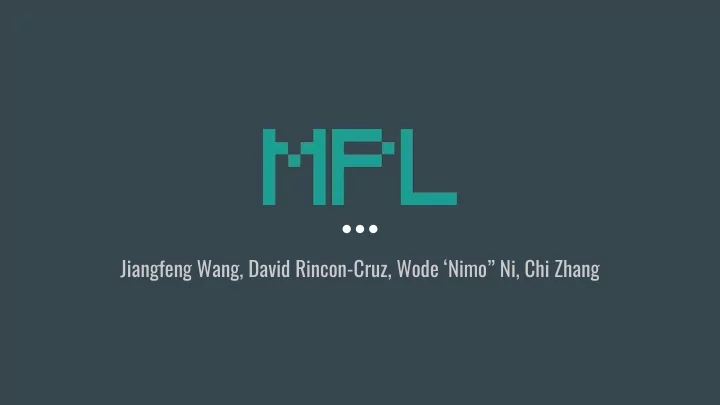

Jiangfeng Wang, David Rincon-Cruz, Wode ‘Nimo” Ni, Chi Zhang
Overview
What is MPL? LLVM Matrices - MPL compiles to LLVM IR - Matrix Arithmetic - LLVM is flexible and works - Apply Function across multiple platforms Motivation - C/Java/Matlab - like Syntax Images - Programmable Matrix - Reading in images Operations - Manipulating Pixels - Lightweight and intuitive - Writing images without math background
Language Syntax
Conditional Operator Programming in MPL == != > < >= <= Logical Operator Comments !, &&, || /* This is a comment*/ Matrix Primitives [1,2;3,4] [1.5,2.5;3.5,4.5] int, float, bool, void, string, Mat Entry function Control Flow int entryf() { if, else, while, return return 1; Arithmetic Operator } + - * / = ++ --
Sample MPL program Calculating GCD
Architecture
Architecture ➔ Added SAST for matrix dimensional information inferred by Semant ➔ C functions for image and console IO ➔ Not too different from MicroC ➔ Generating code for the Apply operator
Generating Code for Entry functions ➔ <function> @ <Mat> ➔ Generate while loops over the target matrix ➔ neighbors passed in by value ➔ Moore neighborhood ➔ Edge problem: a torus!
Testing
Testing ➔ Scanner test and Program test ➔ MicroC’s style of test is efficient.
➔ For our language, printm() is the most useful function for testing. ➔ Example : @ Apply test
Project Management
Project Timeline 2/8 3/5 3/28-5/8 Project Scanner, Semantic checker, Codegen Proposal parser, ast 2/22 3/28 LRM Hello World
Project Management ➔ 3-4 weekly meetings ➔ TA advising meetings ➔ Dividing tasks and pair programming ➔ Multiple branches
Contribution Jiangfeng and David: Design, scanner, parser, ast, semantic checker, sast Nimo and Chi: Skeleton of Scanner and Parser, Codegen, example programs, test suite, game of life
Lessons Learned
Lessons Learned Jiangfeng: Start early. Micro C and previous projects are extremely helpful as sources of instruction. David: It’s better to argue out the features of the language so that everyone is on board. Pair programming keeps everyone on board and provides sanity checks. Chi: Understanding of code is important. Especially when you try to learn from previous project. Nimo: Frequency of the meetings is important. Incremental development is always better than merging big chunks of code
Conway’s Game of Life Any live cell with fewer than two live ➔ neighbours dies, as if caused by underpopulation. Any live cell with two or three live ➔ neighbours lives on to the next generation. Any live cell with more than three live ➔ neighbours dies, as if by overpopulation. Any dead cell with exactly three live ➔ neighbours becomes a live cell, as if by reproduction. There are known patterns ➔
Demo ➔ Image Convolution ➔ Game of Life Simulation
Recommend
More recommend